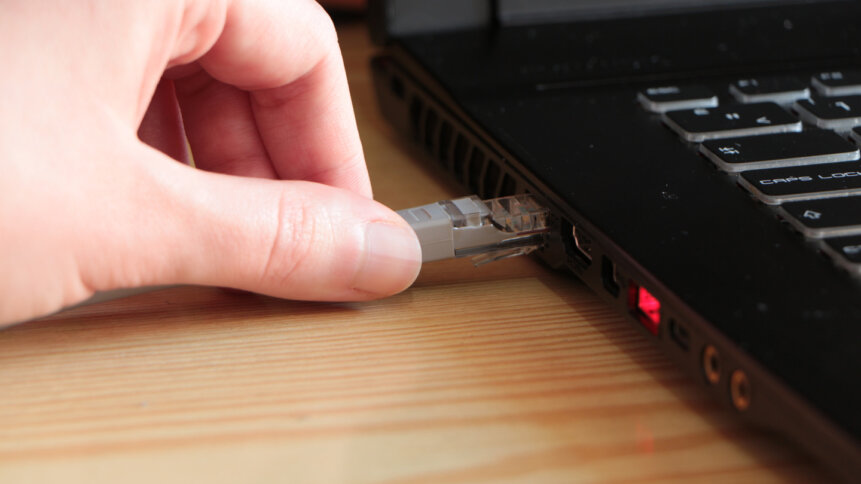Wired or wifi computer connection?

When it comes to the question of whether you should use a wired or wifi computer connection, the answer really depends on which is your greater priority – speed and strength, or portability and convenience?
In the post-lockdown era, with the rise and rise of the hybrid and remote worker as a normal part of teams around the world, wifi connection has become significantly more popular than it had previously as an option for doing work.
That’s because not only is wifi by far the preferred way of connecting to the internet at home (whether you use laptops, desktops, or tablets), it’s also more or less the only way to connect to the net in public venues like coffee shops, diners, libraries, and others.
That makes wifi a clear winner in terms of portability and convenience – being able to plug into the net wirelessly almost everywhere really opens up the world of work environments, which in the post-pandemic era is more important than we ever realized it was before we were locked down for extended periods.
Latency.
But there are downsides to wifi too. In the first instance, there’s a latency issue – which means it takes longer for your commands to connect to the internet, and longer for the page you’re calling to display, simply because of the physics of sending data through what is, effectively, “the air,” with all the natural resistance that implies.
Comparing a wired connection to that wifi latency is like comparing a prizefighter’s punch to an accountant’s finger-poke. Wired connection can be considered particularly “dedicated” to getting your commands and results to and from your computer, with a lot less latency. It will still have some latency, because physics at the moment remains an unbeatable traffic cop, and it still takes commands time to go down wires and back, but the latency is significantly smaller.
While this depends of course on the modernity of your wifi and the conductivity of your cabling, you can regularly get a 0.3ms “ping” on a wired connection – that’s the time it takes for a signal to leave your computer, reach the internet and come back to you. Compared to which, a fairly standard wifi ping rate is 2-3 whole milliseconds. So you could be looking at a connectivity latency up to ten times as long whenever you’re using a wifi computer connection as you’d have when using a wired connection.
How patient are you? Incidentally, that’s why the laptop market is increasingly insisting on using wifi 6 – it can bring the ping latency reliably down to 1ms. Just over three times as slow as a wired connection.
Uploads and downloads in my lady’s chamber.
Those ping latencies show themselves in other ways too. Usually, wired connections offer significantly higher uploads and download speeds. While this again depends on a range of factors, a standard wired connection should be able to give you download speeds of 60mbps, and upload speeds of around half that, at 30mbps.
Average home wifi – the thing you pay for diligently every month – is likely to get you download speeds of just 20mbps, and upload speeds of… weirdly, not half that, but 75% of that, at 15mbps.
Again, the question is how patient are you? Increasingly, wifi speed is being normalized as “just the way things are” – because fewer and fewer people are using wired connections in any part of their lives. In the battle between speed and security versus convenience, convenience is absolutely winning around the world, but if you absolutely, positively, have to have fast downloads and rapid connectivity, you can either pay for “superfast” broadband (assuming you live in an area where it’s available), which will get you up to standard wired connection speed… or you can plug your laptop into a wired connection and prepare to have your mind boggled at the speeds you can achieve.
Security.
It’s also worth noting that in the wake of the pandemic, when people could begin to work in public venues again, the number of cyberattacks suffered by companies around the world soared to unprecedented levels, because for the first time, there was mass remote working, and people were using an unsecured wifi connection in public places.
While no system that involves connecting to the internet will be entirely safe on both ends of the connection, it’s fair to say that wifi computer connection is significantly more open to opportunistic cybercriminals, who are able to use a raft of measures to connect to your machine – and from there, connect to your business’ data, than is possible with a rigorous wired computer connection. The route to the router in a wifi computer connection is vulnerable, and the router itself is frequently easily compromised, so you run much more of an inherent risk to your data, and your company’s data, when you go wireless than when you go wired.
The importance of convenience.
Does any of this stand up to the convenience of being able to use a wifi computer connection almost ubiquitously, anywhere you go?
Probably not in the long run. As we said, the convenience has become a fundamental part of the way we connect in the 21st century, as wifi has become more and more widely available. Had the tradition developed that, for instance, every table in every coffee shop had a wired internet connection, it might have rebalanced the convenience factor to some degree, but wired connections were effectively doomed by the rise and rise of the smartphone.
No-one in the 2020s would even conceive of plugging in a smartphone to get a safer connection. We plug in for power, nothing more and nothing less. And that means smartphones – with their wifi connectivity – have driven the expectation that we’ll be connecting over wifi for most of our lives.
Despite its relative strength and speed, it seems inescapable that wifi computer connections, with all their convenience, will continue to erode the position of wired connections over the next ten years.










